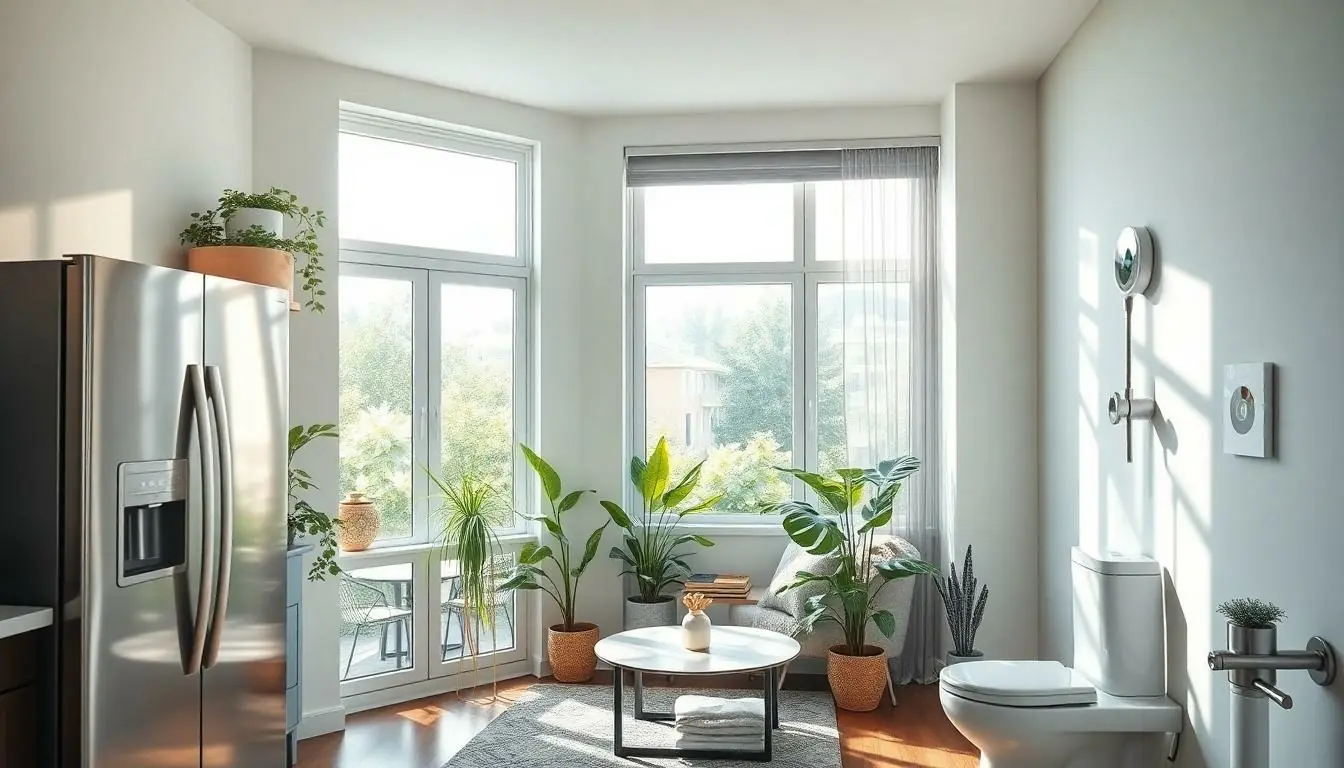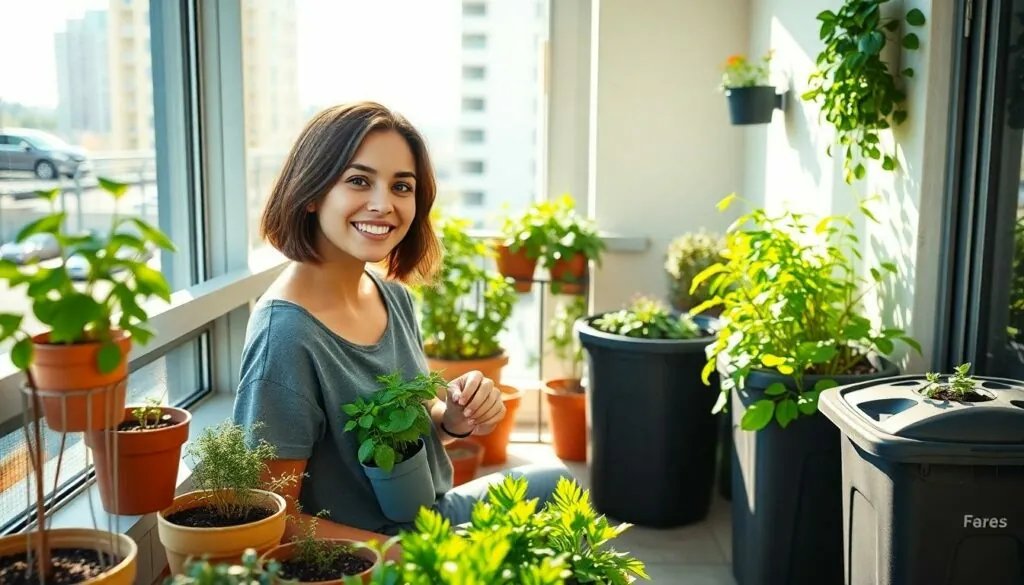Table of Contents
ToggleImagine living in an apartment that not only feels like home but also gives Mother Earth a high-five every day. Sustainable apartment living isn’t just a trend; it’s a lifestyle that combines comfort with eco-friendliness. With a few simple tweaks, anyone can transform their space into an oasis of sustainability, proving that going green doesn’t mean sacrificing style or convenience.
From energy-efficient appliances to composting bins that even your neighbors will envy, sustainable living is all about making smart choices. Plus, it can save money and help the planet—talk about a win-win! Dive into the world of sustainable apartment living and discover how to turn your cozy space into an eco-friendly haven that’s both chic and conscious. After all, who wouldn’t want to be the coolest green warrior on the block?
Overview of Sustainable Apartment Living
Sustainable apartment living integrates comfort with eco-friendliness. It combines conscious choices that promote a healthier environment with modern conveniences.
Key Concepts of Sustainability
Sustainability emphasizes reducing waste and conserving resources. Energy efficiency plays a pivotal role, with appliances designed to minimize energy consumption. Water conservation strategies, like low-flow fixtures, significantly reduce water usage. Choosing sustainable materials for decor minimizes environmental impact. Community engagement enhances sustainability efforts, fostering shared resources among residents.
Benefits of Sustainable Living in Apartments
Financial savings result from lower utility bills due to energy-efficient practices. Health improvements arise from better air quality linked to eco-friendly materials. Residents often experience a sense of community, as like-minded individuals come together. Sustainable living can increase property value, attracting environmentally conscious tenants or buyers. Positive environmental impact resonates, as individual actions contribute to broader ecological benefits.
Eco-Friendly Design Features

Eco-friendly design features play a critical role in sustainable apartment living. These aspects enhance comfort while minimizing environmental impact.
Energy Efficiency Solutions
Energy-efficient solutions significantly reduce power consumption. LED lighting offers a longer lifespan and uses less energy than traditional bulbs. Appliances with the ENERGY STAR label operate at higher efficiency, contributing to lower utility bills. Smart thermostats adjust temperature settings automatically, promoting optimal energy use. Additionally, high-performance windows minimize heat loss, keeping apartments cozy in winter months and cool during summer. Together, these elements create a more sustainable living environment.
Water Conservation Techniques
Water conservation techniques help preserve this vital resource. Low-flow showerheads reduce water usage without sacrificing pressure. Dual-flush toilets provide options for liquid and solid waste, decreasing overall water consumption. Rainwater harvesting systems collect and store rainwater for landscape irrigation, effectively reducing reliance on municipal sources. Drip irrigation systems deliver water directly to plant roots, minimizing evaporation and runoff. Implementing these technologies fosters responsible water use in sustainable apartments.
Sustainable Materials and Practices
Sustainable materials and practices play a crucial role in eco-friendly apartment living. They enhance comfort while minimizing environmental impact.
Green Building Materials
Selecting green building materials significantly reduces environmental footprint. Materials such as bamboo, reclaimed wood, and recycled metal not only minimize waste but also promote sustainability. Low-VOC paints, adhesives, and finishes improve indoor air quality while ensuring safer living conditions. Additionally, products made from natural fibers, like wool and organic cotton, offer sustainable alternatives for furniture and decor. Incorporating these materials supports a healthier lifestyle and helps decrease dependency on nonrenewable resources.
Waste Management Strategies
Implementing effective waste management strategies boosts sustainability in apartments. Recycling programs encourage residents to sort and dispose of materials correctly, reducing landfill waste. Composting organic waste transforms scraps into nutrient-rich soil, contributing to local gardens. Multi-functional furniture aids in minimizing waste by combining storage and utility. Educating residents about proper disposal practices fosters a community of sustainability-minded individuals. By prioritizing these strategies, apartment dwellers can significantly lessen their environmental impact.
Community and Lifestyle in Sustainable Apartments
Sustainable apartments foster a nurturing community that prioritizes eco-friendly practices. Residents interact with like-minded individuals, creating a supportive environment for sustainability initiatives. Encouraging participation in communal gardens allows residents to grow their own food while promoting biodiversity. Sharing resources like tools and appliances minimizes waste and strengthens bonds among neighbors. Accessible recycling and composting stations encourage responsible waste management, further enhancing commitment to sustainability.
Promoting a Green Community Culture
Building a green community culture starts with residents’ shared values. Events like eco-workshops or clean-up drives engage individuals while promoting sustainable practices. Neighborly connections grow stronger through community potlucks that focus on plant-based dishes. Celebrating Earth Day together cultivates awareness and deepens dedication to environmental stewardship. Open discussions around sustainable living practices inform and inspire residents to adopt green habits. As a result, collective efforts lead to a more eco-conscious apartment environment.
Engaging with Local Sustainable Initiatives
Connecting with local sustainable initiatives elevates community involvement. Many apartment complexes partner with nearby organizations to host tree planting events, which help mitigate urban heat. Community-supported agriculture (CSA) programs provide residents access to fresh, local produce, fostering healthy habits. Volunteering for local environmental clean-up efforts engages residents in meaningful work, strengthening community ties. Collaborating with local businesses that prioritize sustainability creates opportunities for discounts and unique partnerships. Each of these initiatives empowers residents to make a positive impact beyond apartment living.
Challenges and Considerations
Sustainable apartment living presents unique challenges. Navigating these obstacles requires thoughtfulness and planning.
Cost Implications of Sustainable Living
Sustainable living often entails higher upfront costs. Energy-efficient appliances and water-saving fixtures may require initial investment. Long-term savings on utility bills significantly offset these expenses. Reduced energy consumption leads to lower monthly costs. Residents frequently find themselves benefiting from government incentives for eco-friendly upgrades. Committing to sustainable practices can lead to valuable financial returns over time. Understanding these cost dynamics helps prospective renters or buyers assess their options.
Availability of Sustainable Apartments
Finding sustainable apartments can be challenging in some areas. Not all developments prioritize green building materials or eco-friendly designs. Urban centers often offer more options due to growing demand for sustainable living. Regional disparities impact access to these apartments significantly. Listings focused on sustainability may use terms like “green living” or “eco-friendly” for better identification. Exploring community resources and local organizations can uncover hidden gems. Engaging with online platforms or networks dedicated to sustainability enhances access to such living spaces.
Sustainable apartment living is more than just a trend; it’s a lifestyle that benefits both individuals and the planet. By adopting eco-friendly practices and making mindful choices, residents can create a comfortable and stylish home while contributing to a healthier environment.
The journey toward sustainability fosters a sense of community and shared responsibility among neighbors. As more people embrace these principles, the collective impact becomes significant. With the right resources and commitment, anyone can transform their living space into a green haven that reflects their values and enhances their quality of life.




